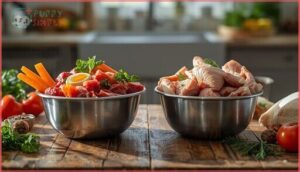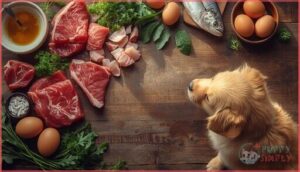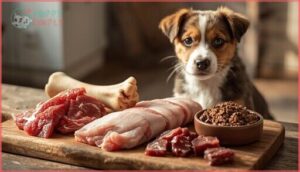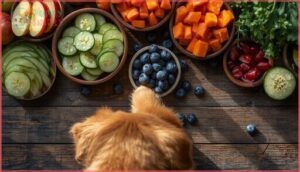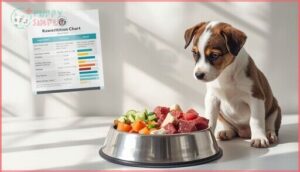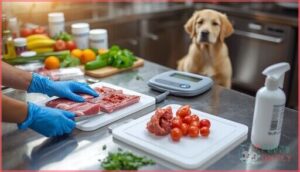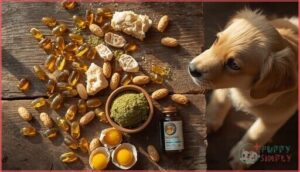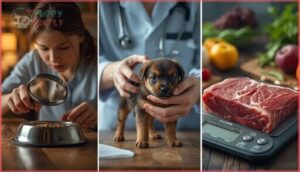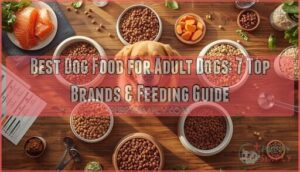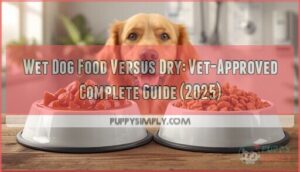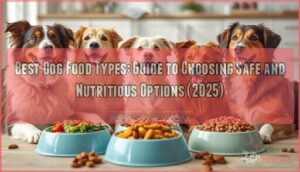This site is supported by our readers. We may earn a commission, at no cost to you, if you purchase through links.
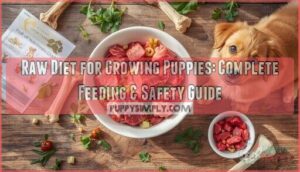
Your puppy’s first year determines whether they grow into a healthy adult or face a lifetime of preventable health issues—and the raw diet for growing puppies has emerged as one of the most debated approaches to getting this critical period right. While conventional kibble dominates the market, a growing number of veterinary nutritionists recognize that carefully formulated raw diets can support ideal development when balanced properly.
The challenge lies in the details: puppies require precise ratios of protein, calcium, and phosphorus that differ markedly from adult dogs, and getting these wrong during rapid growth phases can lead to skeletal deformities or developmental delays. You can’t simply toss your puppy a chicken wing and call it a meal.
Success with raw feeding depends on understanding the specific nutritional demands of growing bodies, implementing rigorous food safety protocols, and knowing exactly how to construct meals that fuel healthy bone development, immune function, and sustained energy.
Table Of Contents
- Key Takeaways
- Key Benefits of a Raw Puppy Diet
- Understanding Raw Diet Models for Puppies
- Essential Nutrients for Growing Puppies
- Creating a Balanced Raw Meal Plan
- Feeding Schedule and Portion Guidelines
- Transitioning Puppies to a Raw Diet
- Food Safety and Hygiene Practices
- Supplementing The Raw Puppy Diet
- Monitoring Puppy Health on Raw Diets
- Common Challenges and Solutions
- Frequently Asked Questions (FAQs)
- Is a raw diet good for puppies?
- At what age can you start a puppy on a raw diet?
- What is the best diet for a growing puppy?
- How do I start my puppy on a raw diet?
- How to safely introduce raw bones to puppies?
- What are the signs of raw food allergies?
- When should organ meats be included in diet?
- Are there risks with a raw diet transition?
- How to store raw food for freshness?
- Can puppies eat raw fish safely?
- Conclusion
Key Takeaways
- Raw diets for puppies require precise calcium-to-phosphorus ratios of 1.2–1.4:1 and carefully balanced protein (25–32%), fat (15–25%), and organ meats to prevent skeletal deformities and developmental delays during critical growth periods.
- Transitioning puppies to raw food demands a gradual 2-week shift with single-protein introductions lasting 8–12 days, as 12–15% of puppies experience digestive upset when proteins change too quickly.
- Rigorous food safety protocols—including freezing at -20°C to reduce bacteria by 99.9%, using dedicated prep tools, and refrigerator thawing—are non-negotiable to protect vulnerable puppies from pathogen exposure.
- Successful raw feeding requires weekly weight monitoring, veterinary check-ups every 3–6 weeks, and careful observation of growth rates (9–12% monthly weight gain), stool quality, and coat condition to catch nutritional imbalances before they cause long-term harm.
Key Benefits of a Raw Puppy Diet
You’re weighing the decision to feed your puppy raw food, and you want to know what real benefits you might see beyond the marketing claims.
The advantages of a well-formulated raw diet extend across several critical areas of development, from what’s happening beneath the surface to what you can observe day to day.
Here’s what the evidence and clinical experience show about how raw feeding can support your growing puppy.
Enhanced Growth and Development
Nutrient balance shapes every stage of your puppy’s development. When you provide well-formulated raw feeding for puppies with proper calcium-to-phosphorus ratios around 1.2:1, you support strong bone health and steady puppy growth and development.
Consider these key advantages:
- Weight gains averaging 4–6% higher monthly in certain cohorts
- More stable growth curves when nutritional balance is maintained
- Increased lean body mass from high-quality animal proteins
- Essential fatty acids supporting neural development stages
A well-planned diet requires careful consideration of literature reviews to guarantee ideal nutrition for puppies.
Improved Coat and Skin Health
Beyond bone and muscle, you’ll notice how raw feeding for puppies transforms coat shine and skin hydration. In one prospective study, 72% of owners reported increased coat gloss within three months on commercial raw diets.
Higher animal fat intake—around 41–52 grams per 1,000 calories—supplies omega balance that bolsters dermatologic health, reduces dull coats by 32%, and improves hair structure while maintaining nutritional balance for peak puppy health and coat condition.
Understanding AP study resources can also help in making informed decisions about puppy nutrition and overall health.
Stronger Immune Function
Just as coat quality reflects external health, immune system strength reveals internal resilience. Puppies fed raw diets with proper nutrient balance show measurable immune gains—lymphocyte counts rise 6–12 weeks in, while organ meats supply iron, zinc, and selenium that fuel innate defenses.
Microbiome development thrives on varied proteins, supporting gut health and pathogen control, provided you maintain cold-chain safety and veterinary oversight for ideal puppy nutrition.
Healthier Digestion
Immune resilience extends inward, where gut health drives nutrient absorption and stool quality. Raw feeding supplies digestive enzymes naturally present in uncooked meats, while balanced protein and fat stabilize the digestive system within 7–14 days.
Probiotic benefits emerge as microbial diversity improves, and firm, minimal-mucus stools signal proper nutritional balance—core markers of successful puppy nutrition through raw diet protocols.
Understanding Raw Diet Models for Puppies
When you start exploring raw feeding, you’ll quickly encounter two main approaches that guide how meals are structured. The BARF model and the Prey Model each take a different philosophy on what belongs in your puppy’s bowl, and understanding their core differences will help you make informed choices.
Let’s look at how these models work and what ingredient ratios will support your growing puppy’s needs.
BARF Vs. Prey Model Explained
Ever wondered which raw feeding model truly aids puppy development? Raw Diet Comparison often centers on the BARF Diet—rich in Raw Meaty Bones and Biologically Appropriate Raw Food—and the Prey Model Raw, which mimics ancestral eating.
Each Feeding Model has distinct Nutrient Ratios and safety considerations, so understanding their structure is essential for diet safety and ideal growth.
Typical Ingredient Ratios
Precision matters in Raw Feeding for Puppies. Typical Dietary Ratios for BARF-style Meal Planning often feature 80% Protein Sources, 10% Bone Content, and 10% organs, supporting Nutrient Balance and Nutrient Requirements. Prey Model approaches lean toward a 70:20:10 split.
These Feeding Guidelines guarantee Biologically Appropriate Raw Food, helping you meet developmental needs while minimizing the risk of nutritional mistakes.
Choosing The Right Model for Your Puppy
Diet Comparison starts with understanding your puppy’s needs. Smaller breeds often do well with BARF’s diverse ingredients, while large breeds may benefit from Prey Model’s higher bone content—if managed carefully.
Your choice in Raw Feeding for Puppies should reflect breed considerations, nutrient balance, and growth targets, supporting ideal puppy nutrition and health through customized dietary management and thoughtful feeding strategies for puppies.
Essential Nutrients for Growing Puppies
For feeding puppies raw, getting the nutrients right matters more than anything. You’ll want to pay close attention to the building blocks that support healthy growth.
Here’s what you need to know about the essentials.
Protein, Fat, and Carbohydrate Needs
Growing puppies need roughly 25–32% crude protein on a dry matter basis to build lean muscle effectively. Your raw diet’s fat content—usually 15–25%—should match your pup’s energy requirements without causing rapid weight gain.
While carbohydrates aren’t mandatory, small amounts of vegetables or fruits can support gut health.
Balancing these macronutrients ensures ideal puppy nutrition and health, meeting both dietary needs and developmental milestones within raw diet frameworks.
Calcium and Phosphorus Balance
Did you know an imbalanced calcium-to-phosphorus ratio can tip the scales toward skeletal problems in puppies? Careful mineral balance is essential for bone growth and canine health. In raw diet puppy care and nutrition, dietary management means keeping calcium intake and phosphorus levels close—ideally 1.2–1.4:1—to support safe development.
An imbalanced calcium-to-phosphorus ratio can cause skeletal problems in puppies, so aim for 1.2–1.4:1 to support safe bone growth
- Bone Growth support
- Nutrient Ratios matter
- Calcium Intake monitoring
- Phosphorus Levels adjustment
- Mineral Balance for wellness
Importance of Organ Meats
Ever wondered why organ variety matters in raw feeding for dogs? Organ meats, packed with nutrient density and bioavailability factors, offer puppies a rich source of vitamin balance and mineral content—think copper, zinc, and vitamin A.
In puppy care and nutrition planning for pets, small, balanced portions support canine health and wellness, but excess can tip the scales toward toxicity.
Creating a Balanced Raw Meal Plan
Building a balanced raw meal plan for your puppy means considering more than just meat. You’ll want to think about bones, organs, and safe produce to support healthy growth.
Here’s what to include as you put together each meal.
Lean Meats, Edible Bones, and Organs
Meat selection shapes your puppy’s health—think lean beef, pork loin, and chicken breast for ideal protein sources in raw feeding for dogs. Bone density matters; ground edible bones support calcium needs without risking choking. Organ variety, like liver and heart, ensures nutrient balance.
Aim for feeding ratios near 45–50% muscle meat, 15–20% bone, and 15–20% organs for complete canine nutrition.
Safe Fruits and Vegetables
Once you’ve balanced lean meats and organs, safe fruits and vegetables can round out your puppy’s raw diet. Apples (cored), carrots, blueberries, and pumpkin all bring fiber and vitamins, making great puppy treats or healthy chews. Sliced cucumbers offer hydration.
Careful Nutrition Planning for Pets means choosing Raw Snacks that support Puppy Nutrition and Diet without risking digestive upset.
Avoiding Common Nutritional Mistakes
While adding fruits and vegetables brings variety, Nutrition Planning for Pets demands vigilance against Nutrient Imbalance. Raw Feeding Errors—like misjudging bone content or skipping organ meats—can trigger Puppy Malnutrition or Nutent Deficiency.
For instance, rapid Dietary Shift or inconsistent schedules often lead to digestive upset. Thoughtful Dietary Management for Puppies, grounded in Nutrition Science, keeps your Raw Diet balanced and aids healthy growth.
Feeding Schedule and Portion Guidelines
Getting the timing and quantity right matters just as much as what goes into your puppy’s bowl. Raw-fed puppies need frequent, carefully measured meals that shift as they grow, and their individual size and breed play a significant role in those calculations.
Let’s look at how to structure feeding schedules, adjust portions appropriately, and track your puppy’s progress to guarantee healthy development.
How Often to Feed Raw Meals
Puppies under six months thrive on three to four raw meals daily, matching their rapid growth phase and elevated caloric demands. As your pup approaches adolescence, you’ll shift to twice-daily feeding schedules, supporting sustained energy and digestive efficiency.
- Meal frequency ensures steady nutrient timing without overloading immature digestive systems
- Structured feeding guidelines for puppies help you monitor intake and stool quality consistently
- Raw portioning adjusts with puppy growth, preventing developmental imbalances
- Dietary management for puppies benefits from routine veterinary check-ins every three to six months
Adjusting Portions by Age and Breed
Generally, you’ll adjust raw portions weekly during early puppy growth stages, calculating 2–3% of expected adult weight for large breeds and 5–10% of current weight for smaller breeds. Breed-specific needs shape feeding frequency and nutrient ratios—giant breeds require controlled growth rates to prevent skeletal issues, while toy breeds demand higher calorie density.
Portion control during diet shifts prevents developmental imbalances as nutritional requirements for dogs shift with puppy development and growth.
Monitoring Growth and Body Condition
Tracking your puppy’s progress demands consistent attention to weight, body scoring, and growth patterns. Weekly weighing detects fluctuations beyond 5% that signal portion adjustments, while body condition scores of 4–5 out of 9 confirm balanced musculoskeletal development throughout growth stages.
- Weekly weight logs reveal whether nutrient balance facilitates healthy puppy development and growth without excess.
- Monthly girth measurements alongside growth rate charts catch atypical growth patterns early.
- Veterinary check-ups every 4–6 weeks validate weight management and health indicators during rapid puppy care and development phases.
Transitioning Puppies to a Raw Diet
Switching your puppy from kibble to raw food isn’t something you rush into overnight. A careful, gradual shift protects your puppy’s digestive system while allowing their gut bacteria to adapt to the new diet.
The following steps will guide you through this process safely, from the initial switch to managing the changes you’ll likely see along the way.
Gradual Switch From Kibble
Switching your puppy to a raw diet requires patience—abrupt changes can lead to digestive upset in 57% of puppies. A slow shift over two weeks is ideal, blending increasing amounts of raw food with kibble while decreasing kibble portions daily.
This diet phasing approach allows the digestive system to adapt, reducing intake drops by 40% and supporting smoother raw introduction while you replace kibble systematically.
Introducing New Proteins Safely
Once your puppy accepts one protein source, you can gradually rotate in others—but don’t rush. Research shows 88% of veterinarians recommend introducing new protein sources slowly; about 12–15% of puppies experience brief digestive upset when switching proteins.
Start with a single novel protein for 8–12 days, then add the next. This measured allergen introduction promotes gut health, meal planning stability, and nutrient balance throughout your raw feeding journey.
Managing Initial Digestive Changes
Your puppy’s gut needs time to adapt—most reach stable digestion within 2–3 weeks of consistent raw feeding. Expect initial adjustments: 10–20% of puppies show soft stools during week one, usually resolving as digestive acclimation progresses.
- Monitor stool quality daily to track nutrient absorption and gut health
- Adjust bone content if stools remain loose beyond day seven
- Maintain hydration to support feeding shifts and GI transit
- Watch for energy shifts indicating dietary planning needs refinement
Patience during diet shift ensures proper puppy development and care.
Food Safety and Hygiene Practices
Raw feeding offers real nutritional benefits, but it also comes with unique responsibilities around food safety.
Puppies are especially vulnerable to pathogens, and your household deserves protection too.
Let’s walk through the practical hygiene steps that’ll keep everyone healthy while your puppy thrives on raw food.
Safe Handling of Raw Ingredients
Did you know freezing raw pet food at -20°C slashes bacteria by 99.9%? That’s why Raw Meat Storage matters so much in Raw Feeding.
Dedicated prep areas and utensils, plus strict Hygiene Practices, keep Cross Contamination at bay.
Follow food safety protocols—thaw in the fridge, wash hands, and label batches—to protect your puppy’s Pet Nutrition and Supplements.
Preventing Pathogen Exposure
Keeping your kitchen safe during Raw Feeding means more than just clean hands. For instance, Sanitization Methods—like using dedicated prep tools—cut Cross Contamination by up to 70%. Food Safety Protocols and regular Pathogen Testing help protect your puppy’s health.
Here’s how you can reduce risk:
- Separate utensils
- Wash surfaces
- Use proper Raw Meat Handling
- Test ingredients
- Follow strict Food Safety
Proper Storage and Thawing Methods
Just as careful sanitization shields your household, proper Freezer Management and Thawing Techniques safeguard Raw Food quality. Always use food-grade Storage Containers, label batches, and store raw meat on the bottom shelf. Temperature Control matters—keep thawed portions at 0–4°C, never refreeze unless cooked.
Here’s a quick comparison:
| Method | Safety Level |
|---|---|
| Refrigerator thawing | Highest |
| Cold-water thawing | Moderate |
| Room temp thawing | Unsafe |
Supplementing The Raw Puppy Diet
Even the most thoughtfully prepared raw meals sometimes need a little extra support. Puppies have unique nutritional needs that can benefit from targeted additions.
Here are some common ways you can supplement your puppy’s raw diet for balanced growth.
Natural Sources of Key Nutrients
Balanced raw feeding means knowing where each nutrient comes from. You’ll want to focus on natural diet staples that support canine health and nutrition. For example, raw bones deliver mineral balance, while organ meats supply vitamin sources. Omega fatty acids from oily fish boost skin and brain health.
Here are four essentials:
- Raw Bones
- Organ Meats
- Protein Sources
- Omega Fatty acids
Probiotics and Digestive Enzymes
Beyond whole foods, probiotic benefits and microbiome balance deserve attention in raw feeding. Multi-strain formulations delivering 10⁹ CFU daily can improve gut health and stool consistency in young dogs experiencing digestive changes.
Enzyme supplements boost nutrient absorption by accelerating protein breakdown during digestion, boosting dry matter digestibility by nearly 19% in some trials.
Both support pet health when shifting to or maintaining raw diets, though food safety and proper supplementation timing matter.
When to Consider Additional Supplements
You’ll occasionally need targeted supplementation when whole foods alone can’t meet your puppy’s nutritional requirements for dogs during rapid growth. Veterinary guidance for pet owners ensures mineral balance and vitamin needs stay aligned with developmental milestones.
- Omega supplements address deficiencies in lean-meat-heavy diets, supporting brain development and reducing inflammation
- Nutrient boosters like vitamin E prevent oxidative stress when feeding polyunsaturated-fat-rich proteins
- Probiotic benefits extend beyond digestion, strengthening immune resilience in puppies shifting between proteins
Proper dog nutrition and supplementation require individualized pet nutrition advice based on breed, growth rate, and dietary composition.
Monitoring Puppy Health on Raw Diets
You can’t just set up a raw diet and walk away—ongoing observation is how you catch problems early and keep your puppy thriving. Knowing what healthy looks like, spotting red flags before they escalate, and partnering with your veterinarian all play essential roles in long-term success.
Let’s walk through the key indicators to watch, the warning signs that demand attention, and how regular check-ups fit into your monitoring routine.
Signs of Nutritional Balance
When your puppy thrives on raw feeding, you’ll notice measurable shifts in health markers that confirm you’re meeting their nutritional requirements for dogs. Growth rates should progress steadily, with puppies gaining 9–12% of their body weight per month, signaling that balanced diets support proper development. Monitor digestive health by evaluating fecal quality—firm, moist stools scoring 3–4 on a 1–5 scale indicate optimized dog nutrition and biologically appropriate feeding.
| Indicator | What to Look For | Timeframe for Change |
|---|---|---|
| Growth Rates | 9–12% body weight gain per month | Ongoing monthly tracking |
| Nutrient Levels | Serum albumin within reference range | 8–12 weeks on diet |
| Digestive Health | Firm stools (score 3–4/5) | 2–4 weeks post-transition |
| Health Markers | Growth plate mineralization on-target | 8–12 weeks on balanced plan |
Recognizing and Addressing Deficiencies
Catching nutrient deficits early prevents long-term complications in your raw-fed puppy. Watch for indicators like stalled growth, dull coat, or persistent loose stools—signs that mineral imbalances or vitamin shortfalls require dietary adjustments. Deficiency prevention hinges on proactive monitoring:
- Track body condition and energy levels weekly to detect shifts before clinical signs emerge.
- Rotate protein sources and organ meats to minimize amino acid or micronutrient gaps.
- Document meal composition to identify patterns when health markers decline.
- Introduce targeted supplementation if bloodwork reveals subclinical deficiencies during diet shift.
Timely intervention safeguards animal health and development throughout raw feeding.
Regular Veterinary Check-Ups
You’ll safeguard your puppy’s development when veterinarian visits track vaccine schedules, growth charts, and health screenings every three to six weeks. Routine appointments deliver nutrition counseling, parasite control, and early detection of orthopaedic or dental irregularities—reducing gastrointestinal issues by 25% in raw-fed puppies.
Veterinary care verifies that your animal’s health and development align with breed-specific milestones, ensuring dog wellness and confident pet care throughout raw feeding.
Common Challenges and Solutions
Even with careful planning, you’ll likely encounter a few bumps along the way as you raise your puppy on a raw diet. Some challenges are common and entirely manageable once you know what to look for.
Let’s walk through three of the most frequent issues and how to address them effectively.
Addressing Picky Eating
Some puppies resist new proteins—up to 40% show initial hesitation tied to neophobia. Picky eater solutions include gradual protein introductions, which reduce meal refusal by about 20% over four weeks.
You can improve nutrient acceptance by offering flavor variety, boosting trial acceptance by 15–25 percentage points. Consistent feeding routines also improve adherence by roughly 12% in controlled studies, helping your puppy adjust to feeding puppies raw food successfully.
Preventing Overfeeding or Underfeeding
Growth monitoring is your safeguard against both extremes. You’ll need to track your puppy’s weight weekly—small breeds should gain 80–120 grams, medium-to-large breeds 150–300 grams during rapid growth.
Calorie control matters: feeding 2–3% of body weight daily promotes healthy development, while split feeding schedules (2–4 meals) maintain steady energy.
Consistent weight management prevents the 15–20% excess that impairs joints or undernutrition that delays maturation.
Dealing With Food Allergies or Sensitivities
Even with balanced raw feeding, about 10–15% of puppies develop food sensitivities—itching, ear infections, or gastrointestinal upset signal potential allergen issues. Food allergy tests aren’t definitive; dietary trial plans remain your diagnostic benchmark.
Here’s your allergen avoidance framework:
- Run an 8–12 week elimination diet using a single novel protein
- Document sensitivity symptoms and ingredient batches for traceability
- Reintroduce proteins one at a time, monitoring reactions closely
Nutrient balancing during trials prevents deficiencies while you identify triggers.
Frequently Asked Questions (FAQs)
Is a raw diet good for puppies?
A species-appropriate approach can nourish your puppy beautifully, yet Raw Diet Benefits demand careful planning.
Feeding Safety and nutritional balance shape outcomes, making Raw Feeding rewarding when Puppy Nutrition is thoughtfully managed through proper Diet Shift protocols.
At what age can you start a puppy on a raw diet?
You can introduce raw feeding once your puppy has been weaned, generally between 6 and 8 weeks of age, as long as nutrient ratios follow established growth guidelines and support immune system development.
What is the best diet for a growing puppy?
A balanced puppy diet delivers 22–32% protein, precise calcium-to-phosphorus ratios near 2:1, and essential fats supporting neural development.
Whether through raw feeding or commercial formulas, nutrient balance and growth monitoring determine ideal outcomes during this critical developmental window.
How do I start my puppy on a raw diet?
Start your puppy on a raw diet gradually over six to twelve weeks, introducing one protein source at a time while monitoring stool consistency.
Consult your veterinarian to ensure proper calcium-to-phosphorus ratios during this transition.
How to safely introduce raw bones to puppies?
Raw bones carry real digestive risks and choking hazards—esophageal obstruction affects 2–3% of puppies during initial exposure.
Supervise closely, avoid brittle fragments, and consult your vet before weaning onto bone-inclusive raw feeding protocols.
What are the signs of raw food allergies?
Itching, redness, hives, ear infections, vomiting, diarrhea, and facial swelling signal potential food reactions.
Dietary triggers—particularly beef, chicken, or dairy—account for 40–60% of confirmed allergies, requiring elimination trials to identify offending proteins and restore skin health.
When should organ meats be included in diet?
Organ Introduction should begin after your puppy’s diet shift stabilizes, usually 2–4 weeks into raw feeding.
Start Liver Introduction first, in small amounts, gradually increasing Meat Variety for Nutrient Balance and Digestive Health, following your Feeding Schedule.
Are there risks with a raw diet transition?
Yes, there are shift risks with raw feeding—digestive upset, temporary immune challenges, and increased pathogen exposure can occur. Nutrient deficits may arise if meal balance isn’t precise, making food safety and gradual diet shift essential for dog care and wellness.
How to store raw food for freshness?
Much like a chef guarding prized ingredients, you’ll want airtight containers, clear labeling, and strict Freezer Management.
Prioritize Storage Hygiene, keep raw food separate, and use proper Thawing Techniques to guarantee Refrigeration Safety and supreme Dog Care and Wellness.
Can puppies eat raw fish safely?
Raw fish carries risks such as parasites like Giardia and bacteria like Salmonella. Certain species may also cause thiamine deficiency.
Freezing can reduce some of these threats, but veterinary guidance typically recommends safer protein alternatives for puppies.
Conclusion
A single miscalculated meal during those critical growth months can ripple through your puppy’s entire life, affecting everything from bone density to immune resilience.
The raw diet for growing puppies demands precision, not guesswork—your commitment to balanced ratios, stringent hygiene, and veterinary oversight determines whether this approach delivers ideal development or unintended harm.
Master the fundamentals outlined here, monitor your puppy’s progress closely, and you’ll build the foundation for lifelong health through nutritionally sound raw feeding.
- https://avmajournals.avma.org/view/journals/javma/243/11/javma.243.11.1549.xml
- https://www.fda.gov/animal-veterinary/animal-health-literacy/get-facts-raw-pet-food-diets
- https://www.cdc.gov/features/salmonellachicken/index.html
- https://onlinelibrary.wiley.com/doi/full/10.1002/vms3.24
- http://geni.us/5kTg9S

